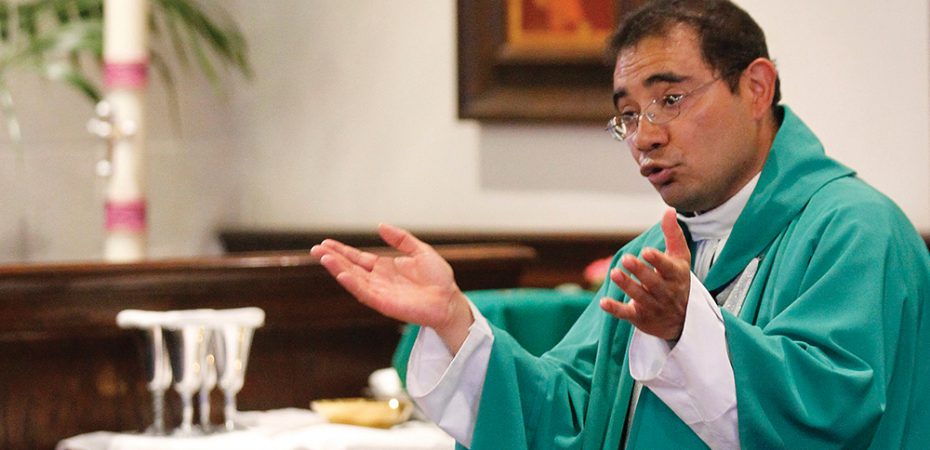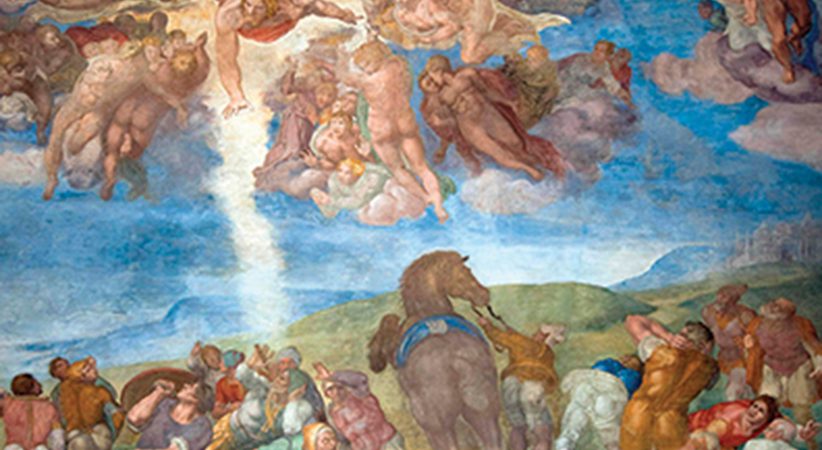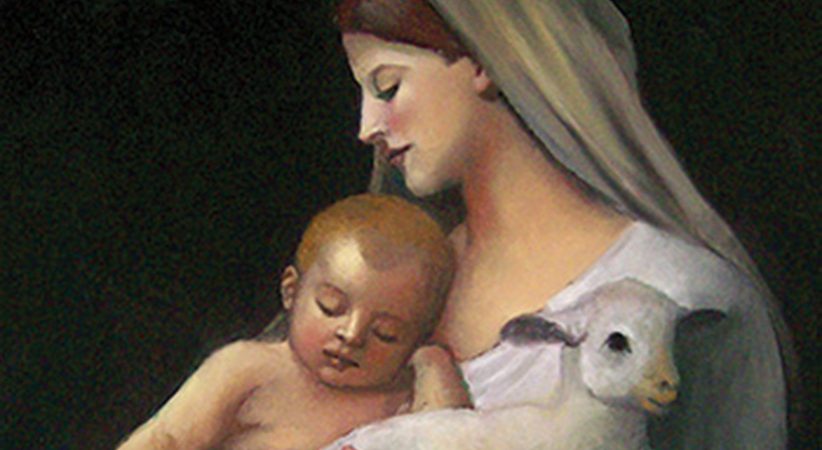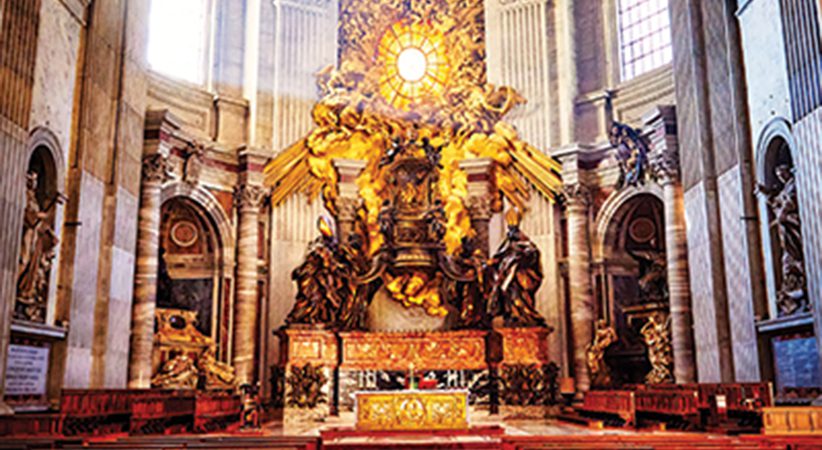Fire and Brimstone: Tips for Preaching the End Times
Why recovering history and theology matters when addressing the Last Things
Father Joshua Whitfield Comments Off on Fire and Brimstone: Tips for Preaching the End Times
Dwight Moody, the great revivalist, appreciated fire and brimstone. He knew nothing better, he said, than the notion “that Our Lord is coming again” to “take the men of this world out of their stocks and bonds.” As a preacher, he knew it worked, that it moved souls.
Moody was thoroughly a preacher of the 19th century, a product of the way many American preachers were then trained. Manuals of preaching and ministry of the era readily encouraged pastors to preach on judgment and hell, so that even the most “perverse and reprobate minds” might be brought to repentance and saved. From George Whitefield sailing across the Atlantic preaching to fellow passengers on the “eternity of hell’s torments” to Jonathan Edwards’ sinners in the hands of an angry God to Charles Finney’s “anxious bench,” it belongs, for better or worse, to the American homiletic tradition — the preached fear of hell.
Also belonging to this tradition is apocalypticism of a rather peculiar kind. These are the various complicated strains of American millenarian theory. Influenced by the likes of John Nelson Darby and others, this originally British version of apocalyptic imagination (which had been questioning the identity of the Antichrist since at least Napoleon III) seeped into American religious consciousness in the latter half of the 19th century and flourished widely into the 20th century, diminishing only in recent years, but certainly not among the fundamentalist fringe. Of the 20th century, one thinks here of John Rice’s influential mid-century fundamentalist newspaper The Sword of the Lord, Pat Robertson’s prediction that the world would end in 1982 and the Left Behind series. This too, for better or worse, marks the legacy of the American pulpit — the preached apocalypse.
And, of course, it’s a tradition not absent from the history of Catholic preaching. Ever since the Jesuits preached with pictures to Native Americans, their illustrated ladders of heaven and hell showing Protestants and unbelievers burning for eternity, or Fulton Sheen warning of a Muscovite Antichrist, Catholic preachers have been quite comfortable in this peculiar realm of religious imagination and experience, though not as numerous and with a distinctly Catholic accent.
Tradition
But what explains this fire and brimstone tradition? And should we rid ourselves of it, and not just from the pulpit but everywhere else? First, in the interest of reality, we must admit that this sort of religious imagination isn’t going away, and that’s because it serves an enduring psychological and social need.
What Hannah Arendt said of ideology and propaganda is true also of much apocalyptic imagination: people often entertain the “fantastically fictitious” not because they are immoral or unintelligent, but because it offers some semblance of conceptual control and self-respect. Which, of course, is not always bad. I think here, for example, not of preachers but blues singers. Often in the blues, there is a lively apocalyptic imagination at work offering relief in troubled times.
Edward James “Son” House, the Depression-era bluesman and former preacher from the Delta, for instance, sang apocalyptically in his “Dry Spell Blues” of a seemingly endless drought: “Oh, it’s a dry old spell everywhere I been / I believe to my soul, this old world is bound to end.” Similarly, in Blind Willie Johnson’s “Jesus is Coming Soon,” about the Spanish flu, he sang, “We done told you, our God’s done warned you, Jesus coming soon.”
Here’s the same fire-and-brimstone tradition found in much early American preaching, yet as blues it’s easier to see how apocalyptic imagination serves to express and assuage anxiety. In fact, like this, when the fire and brimstone tradition is employed against power and random fate rather than for it (which is its original function), it’s easier to see how it belongs to the preaching of justice and peace.
One thinks here of such diverse voices like Frederick Douglass, fighting slavery and racism, asking, “Will not a righteous God visit for these things?” Or even St. Basil the Great, during a famine, who warned the hardhearted, “Think reasonably about that which is and that which shall come … the ever-burning fire, Gehenna, punishments, and bitter things in eternal agony.”
‘Think of Hell’
What then should preachers make of this fire-and-brimstone tradition in the 21st century? How should we preach judgment, hell and heaven today? Preaching to his parish (again, going back to the 19th century), St. John Vianney said, “I beg you: think of hell.” If this no longer is good homiletics, what is? It’s impossible, of course, simply to eliminate the Last Things from one’s preaching unless one wants to preach something other than the Gospel.
Whatever one thinks of apocalyptic imagination, its essence is credal and biblical, de fidei. Thus, for the Catholic preacher, it’s not a matter of if one chooses to preach the Last Things, but how.
First, it’s important preachers recover the apocalyptic imagination of earlier Christianity, with which the particularly American and British traditions of fire and brimstone share little. At best, the terrifying imagery we customarily associate with the Last Things is of medieval origin.
In the first centuries of the Church, by contrast, apocalyptic imagination was determined more by hope than fear. Certainly, theologians like David Bentley Hart exaggerate early Christian optimism.
Nonetheless, early Christians indeed conceived and contemplated eschatology differently. Now, they were no less worried about demons (certainly more so), yet they more readily dreamt of the glory of heaven and the majesty of God than of fire and eternal torment. They too read of the seals, the bowls of God’s wrath, Babylon and the smoke, which will rise from her forever, but they were generally more diffident before the enigma of such imagery.
Hope, Not Fear
Perhaps explicable by the better Platonism of early Christianity, why it’s different is of secondary interest. For preachers, what matters is that they don’t fall victim to a narrow and, historically speaking, quite recent way of engaging the Last Things, but that they recover the ancient art of preaching eschatology as hope instead of fear.
Which means, theologically speaking, we remember that eschatology is soteriology rooted in Christology. As Pope Benedict XVI taught, the transformation we call purgatory is nothing other than the “encounter” with Christ. It is “the inwardly necessary process of transformation in which a person becomes capable of Christ, capable of God and thus capable of unity with the whole communion of saints,” he wrote in his book “Eschatology: Death and Eternal Life.”
Thus, to think about and then preach the Last Things, we must first remember all Paul said: that in the believer it’s Christ who lives (cf. Gal 2:20), that the believer’s life is “hidden with Christ in God” and “will appear with him in glory” (Col 3:3, 4), and as “in Adam all die, so too in Christ shall all be brought to life” (1 Cor 15:22).
………………………………………………………………………………………………………………………………………………………….
From the Saints
Father Whitfield relates how Sts. Jerome and Augustine offer a perspective on the apocalypse:
It was St. Jerome who said, “The apocalypse has as many mysteries as it does words.” Rather, more energy was expended thinking on heaven, what Augustine imagined an eternal “eighth day.” “There we shall be still and see,” he said; “we shall see and we shall love; we shall love and we shall praise. Behold what will be, in the end, without end!” It’s a spiritual difference of emphasis, which sets earlier apocalyptic imagination apart from its modern, darker offspring.
…………………………………………………………………………………………………………………………………………………………..
Such is often what’s missing theologically from apocalyptic preaching, that it’s our union with and in Christ, which is the axis of the universe and the light, which guides us through history. A theological error explaining how so much apocalyptic preaching becomes divisive and merely the rhetorical naming of enemies, damning them to an imagined eternal torment, at the bottom, it is also the absence of the preached Christ, vendetta instead of Gospel.
Recovering history and theology matters for the preacher desiring to preach the Last Things, especially when the texts and liturgies of Advent and Christmas come around, which is when one often feels called upon to do so. And perhaps it matters more in such strange times as ours, troubled as so many of us are by the recent experience and by the forebodings of darker horizons. Wiser historically and more sound theologically, preachers must transcend the limits of the narrower, modern traditions of fire and brimstone, better to preach Christ’s exhortation to be watchful (cf. Mk 13:33), and also better to preach the advent, which is the glorious coming of Christ, and appearing more like Christmas than hell, and which is a better word for our people, forming watchful hearts, purified before joy, not cowering at all.
FATHER JOSHUA J. WHITFIELD is pastoral administrator at St. Rita Catholic Community in Dallas, Texas, and author of “The Crisis of Bad Preaching: Redeeming the Heart and Way of the Catholic Preacher” (Ave Maria Press, $17.95).





